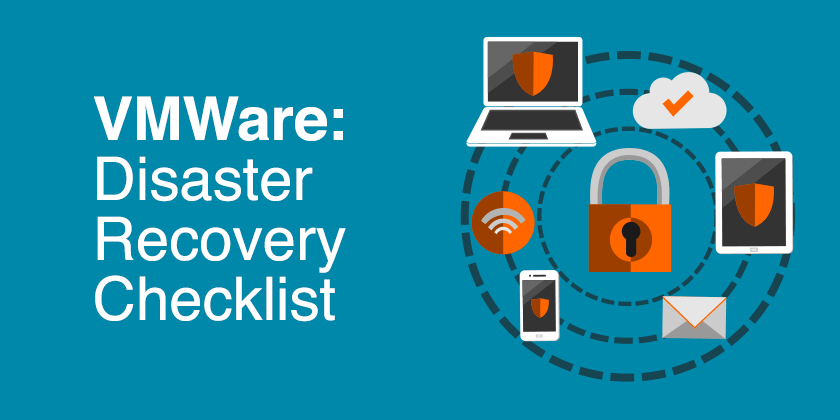Having a strong VMware disaster recovery plan is very important because one mistake or system failure can crash your business.
Many companies forget key steps and lose important data.
In this blog, you will learn the 6 essential steps for VMware disaster recovery, how to build your checklist, and simple tips to protect your business and keep everything running during any disaster.
What Is VMware Disaster Recovery?
VMware Disaster Recovery (DR) is a collection of strategies and processes that aim to protect virtualized environments from unexpected disruptions, data loss, or system failures. Downtime can be your worst enemy as it disrupts key business processes, considering that VMware hosts multiple virtual machines (VMs) on physical hosts.
A solid VMware disaster recovery plan guarantees that your virtual infrastructure can be restored quickly after disasters, including hardware failures, cyberattacks, or natural calamities. It involves creating data backups, replicating data in real time, and using failover systems to ensure minimal downtime and keep operations running smoothly.
This is why companies strive to create a strong VMware disaster recovery plan to protect their critical applications and sensitive data from threats and, should the worst happen, get back to normal as quickly as possible.
Why Is VMware Disaster Recovery Important?
The real question is: How important is your company’s virtual environment? A VMware disaster recovery plan is the key to keeping your operations running when the worst happens. If one does, you should be prepared for data loss, long downtime, and financial loss.
A VMware DR plan that works efficiently reduces these risks by enabling rapid recovery methods that restore VMs and data without affecting security or compliance. Industries such as finance, healthcare, and government have so many regulatory requirements for disaster recovery that it’s simply a requirement.
In short, a VMware DR strategy will ensure that your business stays safe from any digital threat.
Questions to Ask Before Starting Your VMWare Recovery Plan
Before starting your VMWare recovery plan, it’s essential to ask the right questions. Here are a few to consider:
1. How do you get started?
Getting started with your VMWare disaster recovery plan is simple when you know what you’re trying to achieve. That’s why it’s critical to identify your company’s goals for disaster recovery by outlining your Recovery Point Objectives, or RPOs and your Recovery Time Objectives, or RTOs.
Start with identifying your organization’s most important VM. This is vital so that you know which VM to turn on first following a disaster. Then determine your enterprise’s RTOs by evaluating the constant frequency rate your data should be backed up to the disaster recovery (DR) site. It’s also vital to copy any backup data to your disaster recovery site for later use when a disaster occurs.
2. What are some important factors for creating a DR site?
When creating a DR site, it’s critical to consider your IT budget, your infrastructure inventory, and your RTOs and RPOs. By making these preparations, you can save time and money in the event of a disaster.
Your budget will determine what kind of DR site you can facilitate, while your RTOs and RPOs will provide guidance on what you need to accomplish when building a remote VMWare DR site. Prepare by account for your organization’s current structure with inventory, and then take into account your budget, RTOs, and RPOs.
3. What environments are best for VMWare DR plans?
VMWare plans work best in large environments, such as enterprises with large infrastructures. However, fully supported VMs with DR tools can also be instrumental in small environments, such as offices with small staffs with multiple sites with a wide selection of VMs.
However, it may not be necessary in the case of just running a single site with a small number of virtual machines. As an alternative, small and medium-sized businesses (SMBs) with single sites running on few VMs can create a backup plan that is strong and enables VM recovery when needed.
4. How does an SRM assist with DR plans?
While SRMs can be challenging to integrate into your environment, they offer a variety of benefits for simplifying the DR planning process. SRMs help to streamline the DR planning process by prioritizing the most critical workloads for the business, testing disaster recovery plans and mitigating recovery time.
5. What are some alternatives to SRM?
When an SRM doesn’t fit within your IT budget or is too complicated to install, you can consider using DR tools provided by a third party. DR tools are an inexpensive alternative to creating DR plans and are useful if you lack VMWare support at your organization.
You can also make it easier to efficiently build a VMWare DR plan by using a VMWare vSphere Replication tool. This replicates virtual machines across storage types despite protocols and storage vendors. It’s an ideal way for SMBs to save money while meeting storage requirements for data as part of their disaster recovery plan.

Key Components of a VMware Disaster Recovery Plan
A VMware disaster recovery plan includes multiple key components that ensure the seamless recovery of the virtual environment whenever a disaster strikes. Here are the essential components that every plan should include:
Backup and Replication Strategy
A robust backup and replication strategy guarantees that vital VMs and data get routinely copied over to secure offsite or cloud-based storage. The result is recovery points that reduce data loss in a disaster.
Recovery Point Objectives (RPO) and Recovery Time Objectives (RTO)
Set clear RPOs and RTOs to outline what data loss is tolerable, and the targeted restoration window for services. You use these numbers to design your DR plan and allocate resources.
Failover and Failback Procedures
Failover mechanisms enable quick transitions to backup processes during primary server failures. Once the issue is resolved, failback procedures can restore operations to the original environment without any data inconsistencies.
6-Point Checklist for VMware Disaster Recovery
43% of companies that experience disaster NEVER reopen. Preparing for a disaster is a must. When you’re creating your VMWare Disaster recovery plans, follow this checklist:
1. Understand your business.
Before you begin preparing your disaster recovery plan, you need to know how a disaster would impact your internal systems. This will help focus your planning efforts and prioritize your disaster recovery plan.
For example, if you work for an accounting firm, you know from February to April your business in full work mode. Data loss and downtime cannot happen during this busy season. To reduce system downtime and the cost of recovery, work with an IT team to prepare for any failures.
2. Budget wisely.
Virtualization software is an investment. And, with VMWare, you can consolidate all your disaster recovery options into one single product. You can backup infrastructures and simplify operations.
If you’re non-technical or it sounds too complicated, partner with an IT team that can help you understand the concerns and realities of system failure.
3. Know your applications.
Every business has applications that are vital to the success of the company. You want to protect these applications first. It’s like buying a house without a roof, restoring applications without a proper plan in place will leave you stuck in the rain.
4. Automate.
Automating your VM inventory can collect information in a virtual environment quick and easy. You can leverage VMWare’s software to ease the tasks of automating. VMWare’s Veeam Reporter allows you to experience the power of data protection, disaster recovery, and systems management solutions in one tool.
Joe Gremillion, the Network Support Specialist for the Dallas County Community College District, said “To virtualize the entire datacenter, we must meet specific PCI DSS requirements, including change and configuration control and management of our virtual machines and vSphere environment,” Gremillion explained. “We had been searching for a single product to handle that requirement, and Veeam Reporter 4.0 is the answer. It will make my job so much easier and help our security administrator sleep easier at night.”
5. Resources.
Ask yourself: How much CPU and memory are used? How much storage do I need? How much bandwidth do I use?
These are all questions you need to answer to prepare for the loss of your datacenter. This will help you understand the resources necessary to automate and plan.
6. Easy Design.
If you have a robust, plan design, you’ll have a more straightforward recovery process. In a disaster, there can be a lot going on in different environments, and it’s possible you might miss something.
If your disaster recovery plan is complicated with multiple steps, you’re more likely to miss something. In a VMWare plan, you can utilize its numerous features to restore.
Best Practices for VMware Disaster Recovery
Implementing VMware disaster recovery best practices will help ensure you get the most from your DR plan, making it work best for you. Here are some key best practices to keep in mind:
Regular Backups and Testing
Always run frequent VM backups and plan to test your recovery process to ensure it works smoothly. Testing serves this purpose by highlighting gaps and assuring that your team is ready to execute that plan under stress.
Automate Recovery Workflows
With VMware tools such as Site Recovery Manager (SRM), you can automate failover and failback. Automation minimizes human error and speeds up recovery times in real-life disaster scenarios.
Document and Update the Plan
Ensure your VMware DR plan is well-documented with procedures, contacts, and recovery steps. Update it regularly for changes in infrastructure, new VMs, or updates to compliance mandates.
Testing & Maintaining Your VMware Recovery Plan
Designing a VMware Disaster Recovery plan is only the beginning—consistent testing and upkeep are essential to ensure your plan will succeed. Testing proves that your recovery objectives can be realized and your team knows the right actions to take in a disaster. Periodic reviews also help detect stale configurations or components you have missed as your virtual environment changes.
This approach allows non-disruptive testing using VMware tools such as SRM or vSphere Replication to simulate failure scenarios without impacting live operations. Regularly conduct these tests — at least quarterly and following major IT changes — to ensure your recovery plan is up to date, effective, and ready to save your business whenever the time comes.
Conclusion
With the rise in data breaches, it’s essential to have a disaster recovery plan that safeguards data and reduces downtime to keep the business going. You can accomplish these goals with a VMWare disaster recovery plan. Include RTOs and RPOs, and verify that each goal is met. Use an SRM or another alternative to help support your DR plan.
Focus on backing up all essential data that your organization will need to run the business to your disaster recovery site, including HTTP certificates. Always test your DR plan, too. By following a recovery disaster checklist, you can ensure every essential data checkpoint is protected.


